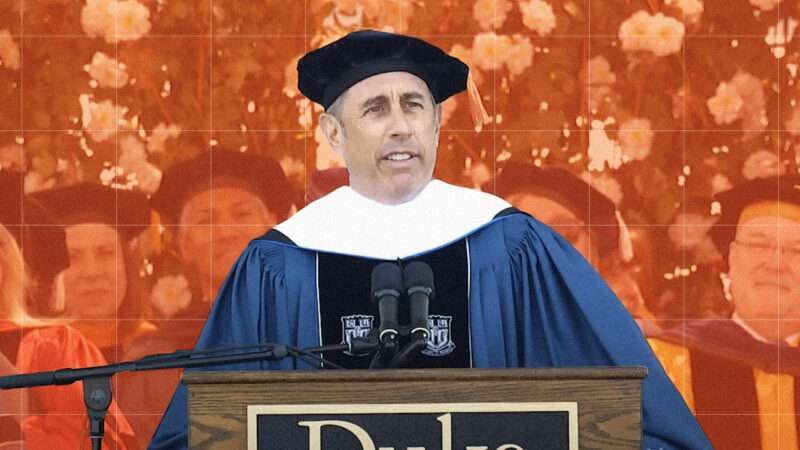'Dozens' of Duke Students Walking Out of Seinfeld's Commencement Speech Is Not a Story

Comedian Jerry Seinfeld on Sunday gave the commencement address at Duke University—a ceremony that was dominated by students walking out in support of Palestine.
Oh, wait. No, it wasn't. But you'd be forgiven for having thought so, as a huge portion of the media coverage bafflingly put that protest front and center, despite that it was a blip on the event's radar.
"Duke students walk out to protest Jerry Seinfeld's commencement speech in latest grad disruption," reads a USA Today headline. "Dozens walk out of Jerry Seinfeld speech at Duke commencement in protest of his support for Israel," reports The Hill. "Duke University students walk out on Jerry Seinfeld's commencement speech, chant 'free Palestine,'" writes Fox News. "Duke students walk out of Jerry Seinfeld graduation speech in Gaza protest," says The Guardian.
I could go on. But I'll bookend the list with an article that, whether it meant to or not, made the case for why the demonstration wasn't really a story at all: "About 30 students walk out on Jerry Seinfeld at Duke commencement," notes Politico.
Thirty students out of the approximately 7,000 graduates and a crowd estimated to be composed of around 20,000 in total. Assuming those numbers are basically correct, that is 0.43 percent of students and 0.15 percent of the audience. Put differently, roughly 99.6 percent of students and 99.8 of the crowd watched Seinfeld's address, which went on undisturbed after a brief period of chanting from the protesters. But it is very likely that many news consumers walked away with the polar opposite impression after consuming the press reports.
The out-of-touch Seinfeld coverage wouldn't necessarily merit a mention if it were an anomaly. The problem: It isn't. It has become fairly standard practice in the press to take voices on the fringe and shove them to the center of the conversation without contextualizing where they came from. Journalists are incentivized to find engaging angles, and fringe characters tend to be interesting. The impulse is understandable. But it creates a distorted picture of reality and comes at the expense of the truth. And journalists should foremost be invested in conveying the truth.
There are many such examples. But in keeping with the protest paradigm, I am particularly reminded of the phenomenon when reporters show up to cover controversial, hot-button demonstrations only to find that there are more journalists in attendance than actual protesters. That's a pretty good clue that the media, perhaps subconsciously, is looking to create a story that isn't really there.
As was the case at Duke. If anything, the demonstration should have been a footnote in the coverage, a line or two. Instead, it was portrayed as the main course. The press has shown a particularly insatiable appetite for stories on Israel-Palestine protests on college campuses; the division sells. Some of those demonstrations have certainly been newsworthy. This one wasn't. Taken as a whole, the coverage unwittingly reenacted an iconic GIF, excerpted from the satire Arrested Development. Except it wasn't supposed to be funny. "There are dozens of us," character Tobias Fünke screams, after being outed as a never-nude. "DOZENS!"
The post 'Dozens' of Duke Students Walking Out of Seinfeld's Commencement Speech Is Not a Story appeared first on Reason.com.

